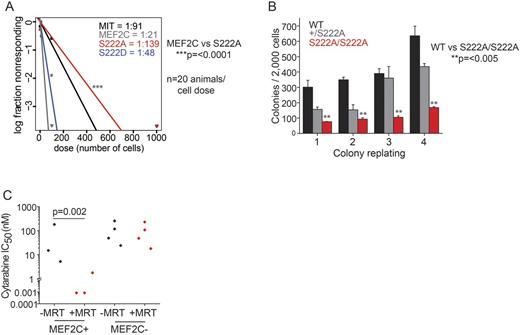Abstract
For patients with acute myeloid leukemia (AML), failure to achieve complete remission after induction therapy or relapse after complete remission represents the major barrier to cure for both children and adults. Although genomics has revealed the mechanisms of pathogenesis of AML, the molecular mechanisms of chemotherapy resistance remain largely unknown. Using high-resolution mass spectrometry proteomics, we identified aberrant phosphorylation of MEF2C S222 in primary chemoresistant human AML specimens, and using capillary nanoimmunoassays, established its prevalence and prognostic significance in a cohort of 40 patients, spanning the major biologic subtypes of human AML, including refractory MLL-rearranged leukemias.
MEF2C is a transcription factor required for hematopoietic cell fate determination. We found that expression of mutant S222A MEF2C that cannot be phosphorylated, but not phosphomimetic S222D, led to a leukemia stem cell defect in genetically-engineered MLL-AF9 mouse leukemias in vivo (Figure 1A). Similarly, loss of MEF2C phosphorylation impeded progression of human AML engrafted in immunodeficient mice in vivo. Using transcriptome and BH3 mitochondrial profiling, we found that loss of MEF2C phosphorylation induced intrinsic mitochondrial apoptosis and sensitization to both cytarabine and doxorubicin, due at least in part to the upregulation of pro-apoptotic factors BID and BMF.
To determine the function of MEF2C phosphorylation in normal hematopoiesis, we used CRISPR/Cas9 genome engineering to generate transgenic mice with endogenous Mef2cS222A/S222A and S222D/S222D mutations. Both transgenic strains were born at Mendelian ratios, exhibited normal steady-state hematopoiesis, and normal reconstitution in competitive bone marrow transplants. In contrast, Mef2cS222A/S222A hematopoietic progenitor cells, transformed with MLL-AF9 oncogenes exhibited reduced colony forming capacity, as compared to transformed MEF2C wild-type litter-mate controls (Figure 1B). Thus, MEF2C S222 phosphorylation is selectively required for the survival of leukemia cells but is dispensable for normal hematopoietic function, establishing a therapeutic window for targeting MEF2C.
To identify kinases that phosphorylate MEF2C and can serve as targets for therapeutic intervention, we screened recombinant serine/threonine kinases and identified the MARK kinase family as the specific enzymes that phosphorylate MEF2C S222. We found that MARK2 and MARK3 are highly overexpressed in the majority of human AML cell lines and primary patient specimens studied. We found that active MARK3, but not its inactive kinase mutants, can trans-activate MEF2C response elements using transcriptional reporter assays in a MEF2C S222-dependent manner. Importantly, MARK kinase inhibition by the ATP competitive inhibitor MRT199665, led to selective apoptosis of MEF2C-expressing human AML cell lines and primary AML patient samples, which conferred enhanced sensitivity to cytarabine (Figure 1C). Thus MEF2C phosphorylation is dispensable for normal hematopoiesis, enhances leukemia cell survival, and causes resistance to chemotherapy and susceptibility to MARK kinase inhibition. These findings establish a paradigm of rational functional therapy of AML chemoresistance.
He:Foundation Medicine, Inc: Employment, Equity Ownership. Letai:Tetralogic: Consultancy, Research Funding; AbbVie: Consultancy, Research Funding; Astra-Zeneca: Consultancy, Research Funding. Gray:Gatekeeper: Equity Ownership; Petra: Consultancy, Equity Ownership; C4: Consultancy, Equity Ownership; Syros: Consultancy, Equity Ownership. Armstrong:Epizyme, Inc: Consultancy.
Author notes
Asterisk with author names denotes non-ASH members.


This feature is available to Subscribers Only
Sign In or Create an Account Close Modal